What Would Be The Change In Temperature Of 275 G Of Water If 36.5 Kj Of Heat Were Added?
On This Page:
- Earth's temperature is a balancing act
- The greenhouse consequence causes the atmosphere to retain estrus
- Changes in the sun's energy impact how much energy reaches Globe'south organisation
- Changes in reflectivity affect how much energy enters Earth's arrangement
Earth's temperature is a balancing act
Click the paradigm to view a larger version.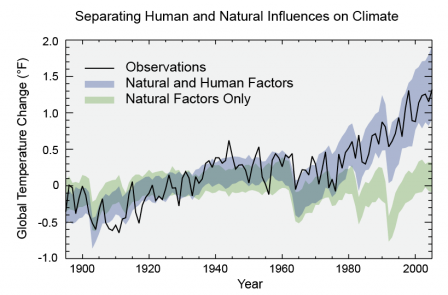 Models that account only for the effects of natural processes are not able to explicate the warming observed over the past century. Models that also account for the greenhouse gases emitted by humans are able to explain this warming.
Models that account only for the effects of natural processes are not able to explicate the warming observed over the past century. Models that also account for the greenhouse gases emitted by humans are able to explain this warming.
- Variations in the sun'southward energy reaching Globe
- Changes in the reflectivity of Earth's atmosphere and surface
- Changes in the greenhouse outcome, which affects the amount of heat retained past Earth's atmosphere
These factors have caused Earth's climate to change many times.
Scientists have pieced together a record of Globe'south climate, dating back hundreds of thousands of years (and, in some cases, millions or hundreds of millions of years), by analyzing a number of indirect measures of climate such as water ice cores, tree rings, glacier lengths, pollen remains, and ocean sediments, and by studying changes in Earth's orbit around the sun.[ii]
This record shows that the climate system varies naturally over a wide range of time scales. In full general, climate changes prior to the Industrial Revolution in the 1700s tin can be explained past natural causes, such every bit changes in solar energy, volcanic eruptions, and natural changes in greenhouse gas (GHG) concentrations.[2]
Contempo climate changes, however, cannot be explained by natural causes lone. Research indicates that natural causes do not explicate virtually observed warming, especially warming since the mid-xxth century. Rather, it is extremely likely that man activities take been the ascendant crusade of that warming.[2]
Top of Page
The greenhouse upshot causes the atmosphere to retain heat
When sunlight reaches Earth's surface, it can either be reflected back into space or captivated by World. Once captivated, the planet releases some of the energy back into the temper as rut (also called infrared radiation). Greenhouse gases similar water vapor (HtwoO), carbon dioxide (COtwo), and methane (CH4) absorb free energy, slowing or preventing the loss of oestrus to infinite. In this way, GHGs act like a blanket, making Earth warmer than it would otherwise be. This process is usually known every bit the "greenhouse event."
The role of the greenhouse upshot in the past
Over the last several hundred chiliad years, CO2 levels varied in tandem with the glacial cycles. During warm "interglacial" periods, CO2 levels were higher. During cool "glacial" periods, CO2 levels were lower.[2] The heating or cooling of Earth'due south surface and oceans tin cause changes in the natural sources and sinks of these gases, and thus change greenhouse gas concentrations in the atmosphere.[2] These changing concentrations are thought to have acted as a positive feedback, amplifying the temperature changes caused past long-term shifts in Globe's orbit.[two]
Click the prototype to view a larger version.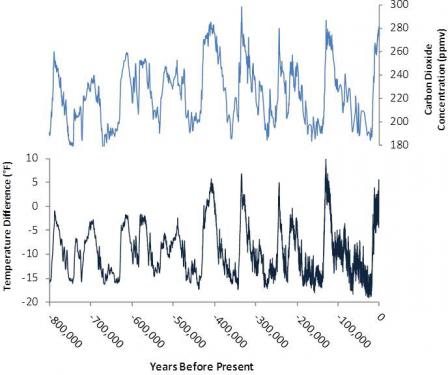 Estimates of the Earth's changing CO2 concentration (top) and Antarctic temperature (bottom), based on analysis of ice core data extending back 800,000 years. Until the past century, natural factors acquired atmospheric CO2 concentrations to vary inside a range of about 180 to 300 parts per meg past volume (ppmv). Warmer periods coincide with periods of relatively high CO2 concentrations. Note: The past century'southward temperature changes and rapid CO2 rising (to 400 ppmv in 2015) are not shown here. Increases over the past half century are shown in the Recent Office section.
Estimates of the Earth's changing CO2 concentration (top) and Antarctic temperature (bottom), based on analysis of ice core data extending back 800,000 years. Until the past century, natural factors acquired atmospheric CO2 concentrations to vary inside a range of about 180 to 300 parts per meg past volume (ppmv). Warmer periods coincide with periods of relatively high CO2 concentrations. Note: The past century'southward temperature changes and rapid CO2 rising (to 400 ppmv in 2015) are not shown here. Increases over the past half century are shown in the Recent Office section.
Source: Based on information appearing in NRC (2010).
Click the paradigm to view a larger version.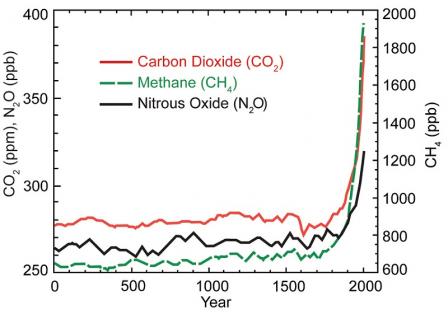 This graph shows the increment in greenhouse gas (GHG) concentrations in the atmosphere over the concluding 2,000 years. Increases in concentrations of these gases since 1750 are due to human activities in the industrial era. Concentration units are parts per million (ppm) or parts per billion (ppb), indicating the number of molecules of the greenhouse gas per meg or billion molecules of air.
This graph shows the increment in greenhouse gas (GHG) concentrations in the atmosphere over the concluding 2,000 years. Increases in concentrations of these gases since 1750 are due to human activities in the industrial era. Concentration units are parts per million (ppm) or parts per billion (ppb), indicating the number of molecules of the greenhouse gas per meg or billion molecules of air.
Source: U.S. National Climate Assessment (2014).
The recent part of the greenhouse issue
Since the Industrial Revolution began around 1750, man activities have contributed substantially to climate change past adding CO2 and other rut-trapping gases to the atmosphere. These greenhouse gas emissions have increased the greenhouse effect and caused Earth'southward surface temperature to rise. The primary human action affecting the amount and rate of climate change is greenhouse gas emissions from the burning of fossil fuels.
The main greenhouse gases
The near of import GHGs straight emitted by humans include carbon dioxide (CO2), methane (CH4), nitrous oxide (NtwoO), and several others. The sources and contempo trends of these gases are detailed beneath.
Carbon dioxide
Carbon dioxide is the primary greenhouse gas that is contributing to recent climatic change. COii is absorbed and emitted naturally every bit function of the carbon bicycle, through plant and animal respiration, volcanic eruptions, and ocean-atmosphere exchange. Human activities, such as the called-for of fossil fuels and changes in land utilise, release big amounts of CO2, causing concentrations in the temper to ascent.
Atmospheric CO2 concentrations have increased by more than xl% since pre-industrial times, from approximately 280 parts per meg by volume (ppmv) in the 18th century to over 400 ppmv in 2015. The monthly average concentration at Mauna Loa now exceeds 400 ppmv for the first fourth dimension in human history. The current COii level is college than it has been in at least 800,000 years.[ii]
Some volcanic eruptions released large quantities of CO2 in the distant past. However, the U.S. Geological Survey (USGS) reports that human activities now emit more than 135 times as much CO2 as volcanoes each year.
Human activities currently release over 30 billion tons of CO2 into the temper every year.[two] The resultant build-up of CO2 in the atmosphere is similar a tub filling with h2o, where more water flows from the faucet than the bleed can take away.
Click the image to view a larger version.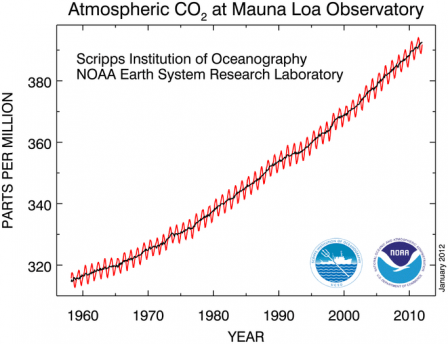 Atmospheric carbon dioxide concentration has risen from pre-industrial levels of 280 parts per million by volume (ppmv) to over 401 ppmv in 2016. Since 1959 lonely (shown here), concentrations have risen past more than 85 ppmv. The yearly ascension and autumn in the nautical chart reflects the growth and disuse or northern hemisphere vegetation.
Atmospheric carbon dioxide concentration has risen from pre-industrial levels of 280 parts per million by volume (ppmv) to over 401 ppmv in 2016. Since 1959 lonely (shown here), concentrations have risen past more than 85 ppmv. The yearly ascension and autumn in the nautical chart reflects the growth and disuse or northern hemisphere vegetation.
Source: NOAA
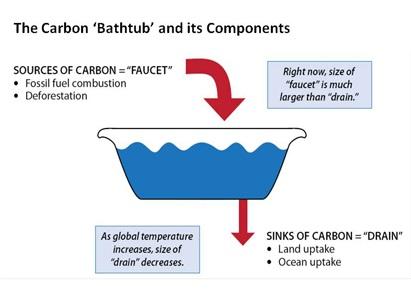 If the amount of water flowing into a bathrub is greater than the amount of h2o leaving through the drain, the water level volition ascension. COii emissions are like the menses of water into the globe's carbon bathtub. "Sources" of COtwo emissions such equally fossil fuel called-for, cement manufacture, and country apply are similar the bathtub's faucet. "Sinks" of COii in the ocean and on land (such as plants) that accept up CO2 are like the drain. Today, homo activities have turned up the flow from the CO2 "faucet," which is much larger than the "drain" can cope with, and the level of COii in the atmosphere (like the level of water in a bathtub) is ascent.
If the amount of water flowing into a bathrub is greater than the amount of h2o leaving through the drain, the water level volition ascension. COii emissions are like the menses of water into the globe's carbon bathtub. "Sources" of COtwo emissions such equally fossil fuel called-for, cement manufacture, and country apply are similar the bathtub's faucet. "Sinks" of COii in the ocean and on land (such as plants) that accept up CO2 are like the drain. Today, homo activities have turned up the flow from the CO2 "faucet," which is much larger than the "drain" can cope with, and the level of COii in the atmosphere (like the level of water in a bathtub) is ascent.
For more information on the human and natural sources and sinks of CO2 emissions, and actions that tin can reduce emissions, see the Carbon Dioxide page in the Greenhouse Gas Emissions website.
Methyl hydride
Methane is produced through both natural and human activities. For example, natural wetlands, agricultural activities, and fossil fuel extraction and ship all emit CH4.
Marsh gas is more abundant in Globe'south atmosphere at present than at whatsoever time in at least the past 800,000 years.[ii] Due to human activities, CH4concentrations increased sharply during most of the 20th century and are at present more than two-and-a-half times pre-industrial levels. In recent decades, the rate of increase has slowed considerably.[two]
For more information on CH4 emissions and sources, and actions that tin can reduce emissions, see EPA's Methane page in the Greenhouse Gas Emissions website. For information on how methane is impacting the Arctic, see the EPA studyMethane and Black Carbon Impacts on the Chill.
Nitrous oxide
Nitrous oxide is produced through natural and man activities, mainly through agricultural activities and natural biological processes. Fuel called-for and some other processes besides create NiiO. Concentrations of Due northtwoO have risen approximately xx% since the commencement of the Industrial Revolution, with a relatively rapid increase toward the end of the 20th century.[two]
Overall, N2O concentrations have increased more chop-chop during the past century than at any time in the past 22,000 years.[2] For more data on NiiO emissions and sources, and deportment that can reduce emissions, see EPA'due south Nitrous Oxide page in the Greenhouse Gas Emissions website.
Other greenhouse gases
- H2o vapor is the most abundant greenhouse gas and also the most important in terms of its contribution to the natural greenhouse upshot, despite having a curt atmospheric lifetime. Some human being activities can influence local water vapor levels. Notwithstanding, on a global scale, the concentration of water vapor is controlled by temperature, which influences overall rates of evaporation and precipitation.[2] Therefore, the global concentration of water vapor is not substantially affected by direct homo emissions.
- Tropospheric ozone (Oiii), which also has a short atmospheric lifetime, is a potent greenhouse gas. Chemical reactions create ozone from emissions of nitrogen oxides and volatile organic compounds from automobiles, power plants, and other industrial and commercial sources in the presence of sunlight. In improver to trapping rut, basis-level ozone is a pollutant that can cause respiratory health problems and damage crops and ecosystems.
- Chlorofluorocarbons (CFCs), hydrochlorofluorocarbons (HCFCs), hydrofluorocarbons (HFCs), perfluorocarbons (PFCs), and sulfur hexafluoride (SFhalf-dozen), together chosen F-gases, are ofttimes used in coolants, foaming agents, fire extinguishers, solvents, pesticides, and droplets propellants. Unlike water vapor and ozone, these F-gases have a long atmospheric lifetime, and some of these emissions will affect the climate for many decades or centuries.
For more than data on greenhouse gas emissions, see the Greenhouse Gas Emissions website, including an expanded discussion of global warming potentials and how they are used to measure out the relative strengths of greenhouse gases. To learn more almost actions that can reduce these emissions, encounter What You lot Tin can Do.
Other climate forcers
Particles and aerosols in the atmosphere can likewise affect climate. Human activities such every bit burning fossil fuels and biomass contribute to emissions of these substances, although some aerosols also come from natural sources such every bit volcanoes and marine plankton.
- Blackness carbon (BC) is a solid particle or aerosol, not a gas, but it also contributes to warming of the temper. Different GHGs, BC can direct absorb incoming and reflected sunlight in improver to absorbing infrared radiation. BC can too be deposited on snow and water ice, concealment the surface and thereby increasing the snow's absorption of sunlight and accelerating melt. For data on how BC is impacting the Arctic, encounter EPA assessmentMethyl hydride and Blackness Carbon Impacts on the Chill.
- Sulfates, organic carbon, and other aerosols can cause cooling by reflecting sunlight.
- Warming and cooling aerosols tin can collaborate with clouds, changing a number of cloud attributes such as their germination, dissipation, reflectivity, and precipitation rates. Clouds tin contribute both to cooling, by reflecting sunlight, and warming, by trapping outgoing oestrus.
For more information on greenhouse gas emissions, encounter the Greenhouse Gas Emissions website. To learn more than about actions that can reduce these emissions, see What EPA is Doing and What You Can Exercise.
Acme of Folio
Changes in the lord's day's free energy affect how much free energy reaches Earth'southward system
Click the prototype to view a larger version.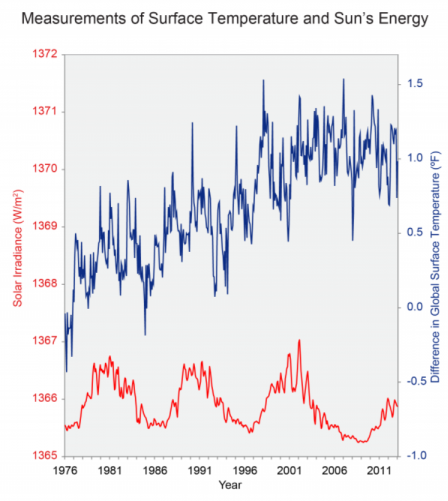 The sun's energy received at the top of Earth's atmosphere has been measured by satellites since 1978. It has followed its natural 11-year cycle of small ups and downs, merely with no net increase (bottom). Over the same flow, global temperature has risen markedly (top).
The sun's energy received at the top of Earth's atmosphere has been measured by satellites since 1978. It has followed its natural 11-year cycle of small ups and downs, merely with no net increase (bottom). Over the same flow, global temperature has risen markedly (top).
Source: USGCRP (2009).
Changes occurring in the sunday itself can affect the intensity of the sunlight that reaches Earth's surface. The intensity of the sunlight can cause either warming (during periods of stronger solar intensity) or cooling (during periods of weaker solar intensity). The sun follows a natural 11-year cycle of small ups and downs in intensity, but the result on Earth's climate is minor.[1]
Changes in the shape of World'due south orbit also as the tilt and position of Earth's axis can also affect the amount of sunlight reaching World's surface.[1] [2]
The role of the sun's free energy in the past
Changes in the dominicus's intensity have influenced Earth's climate in the past. For case, the so-called "Footling Ice Historic period" betwixt the 17th and 19th centuries may have been partially acquired by a depression solar action phase from 1645 to 1715, which coincided with cooler temperatures. The "Little Ice Historic period" refers to a slight cooling of Northward America, Europe, and probably other areas effectually the globe.[two]
Changes in Globe'due south orbit have had a big impact on climate over tens to hundreds of thousands of years. In fact, the amount of summer sunshine on the Northern Hemisphere, which is affected past changes in the planet'due south orbit, appears to drive the accelerate and retreat of ice sheets. These changes appear to be the chief cause of past cycles of water ice ages, in which Earth has experienced long periods of cold temperatures (water ice ages), as well as shorter interglacial periods (periods between ice ages) of relatively warmer temperatures.[1] [two]
Rates of Climatic change Have Varied Over Time
 Click to learn about how rates of climate change take varied over time.
Click to learn about how rates of climate change take varied over time.
The recent role of the sun'due south free energy
Changes in solar free energy keep to touch climate. However, over the last xi-year solar cycle, solar output has been lower than information technology has been since the mid-20th century, and therefore does not explain the recent warming of the earth.[2] Similarly, changes in the shape of Earth's orbit as well as the tilt and position of World'southward axis affect temperature on very long timescales (tens to hundreds of thousands of years), and therefore cannot explicate the recent warming.
Changes in reflectivity affect how much energy enters Earth's organization
When sunlight reaches World, it can be reflected or absorbed. The corporeality that is reflected or absorbed depends on Globe'southward surface and temper. Light-colored objects and surfaces, like snow and clouds, tend to reflect nigh sunlight, while darker objects and surfaces, similar the ocean, forests, or soil, tend to absorb more sunlight.
The term albedo refers to the amount of solar radiations reflected from an object or surface, often expressed as a percentage. Earth every bit a whole has an albedo of about 30%, pregnant that 70% of the sunlight that reaches the planet is absorbed.[3] Absorbed sunlight warms Earth'southward land, water, and atmosphere.
Reflectivity is also affected past aerosols. Aerosols are small particles or liquid droplets in the atmosphere that tin can absorb or reflect sunlight. Unlike greenhouse gases, the climate effects of aerosols vary depending on what they are made of and where they are emitted. Those aerosols that reflect sunlight, such as particles from volcanic eruptions or sulfur emissions from called-for coal, take a cooling event. Those that blot sunlight, such equally black carbon (a office of soot), accept a warming consequence.
The role of reflectivity in the by
Natural changes in reflectivity, like the melting of sea ice, have contributed to climate change in the past, frequently interim equally feedbacks to other processes.
Volcanoes have played a noticeable role in climate. Volcanic particles that reach the upper temper can reflect enough sunlight back to space to cool the surface of the planet by a few tenths of a degree for several years.[2] These particles are an example of cooling aerosols. Volcanic particles from a single eruption do not produce long-term change considering they remain in the temper for a much shorter time than GHGs.[ii]
The contempo role of reflectivity
Human changes in country employ and state embrace have changed Earth's reflectivity. Processes such as deforestation, reforestation, desertification, and urbanization often contribute to changes in climate in the places they occur. These furnishings may be pregnant regionally, just are smaller when averaged over the unabridged globe.
In addition, human activities accept generally increased the number of aerosol particles in the atmosphere. Overall, human-generated aerosols have a net cooling effect offsetting well-nigh one-tertiary of the total warming effect associated with human greenhouse gas emissions. Reductions in overall droplets emissions can therefore lead to more warming. However, targeted reductions in black carbon emissions can reduce warming.[ane]
Top of Folio
References:
[1] USGCRP (2014). Climate Change Impacts in the Us: The Third National Climate Cess. [Melillo, Jerry M., Terese (T.C.) Richmond, and Gary W. Yohe, Eds.] U.S. Global Alter Research Program.
[2] IPCC (2013).Climate change 2013: The Physical Science Basis.Contribution of Working Group I to the 5th Assessment Report of the Intergovernmental Console on Climatic change [Stocker, T.F., D. Qin, G.-K. Plattner, M. Tignor, South.G. Allen, J. Boschung, A. Nauels, Y. Xia, Five. Bex and P.M. Midgley (eds.)]. Cambridge University Press, Cambridge, United kingdom and New York, NY, The states.
[iii] NRC (2010).Advancing the Science of Climate Changes . National Research Quango. The National Academies Press, Washington, DC, United states.
Top of Folio
Source: https://19january2017snapshot.epa.gov/climate-change-science/causes-climate-change_.html
Posted by: tobinmors1941.blogspot.com


0 Response to "What Would Be The Change In Temperature Of 275 G Of Water If 36.5 Kj Of Heat Were Added?"
Post a Comment